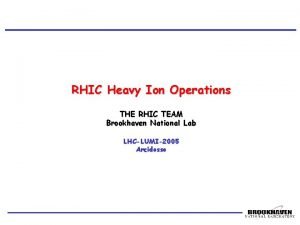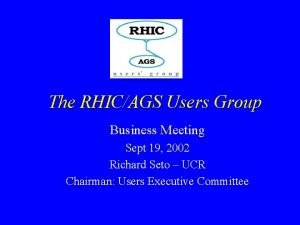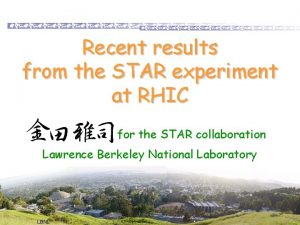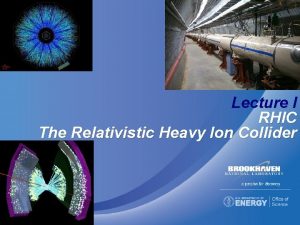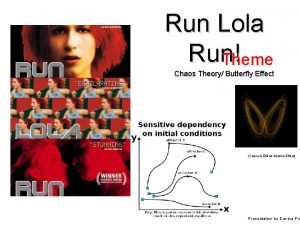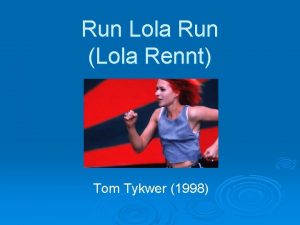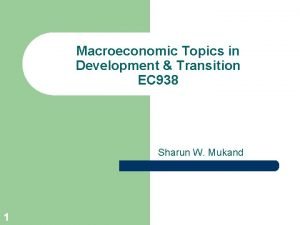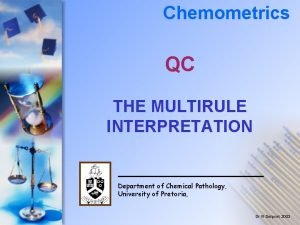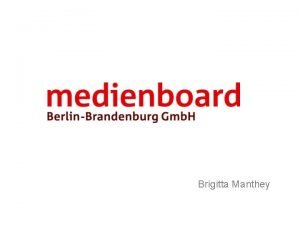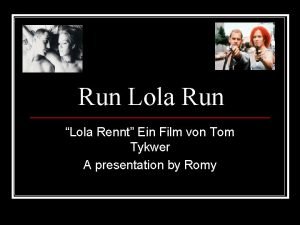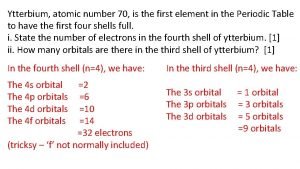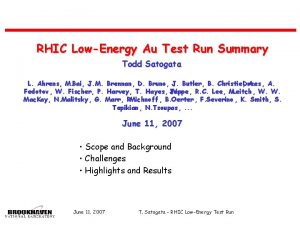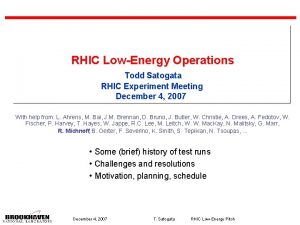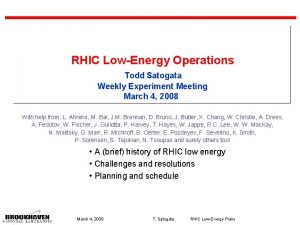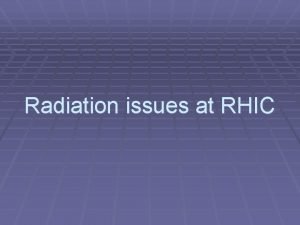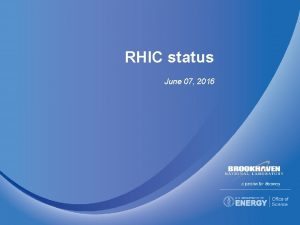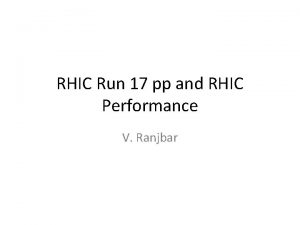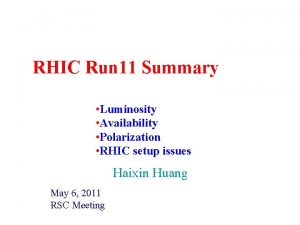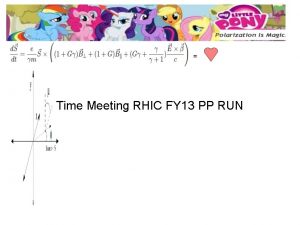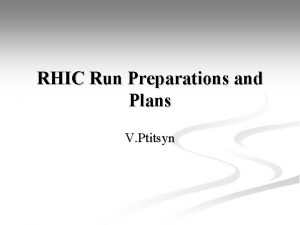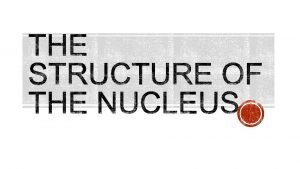A RHIC LowEnergy Test Run With Protons Todd


![Proton/Gold parameters at same rigidity Protons Gold s [Ge. V] 22. 5 9. 18 Proton/Gold parameters at same rigidity Protons Gold s [Ge. V] 22. 5 9. 18](https://slidetodoc.com/presentation_image/381124554efb994d0355558bfad59082/image-3.jpg)
![Testing RHIC RF, h=363 Protons Gold s [Ge. V] 15. 0 6. 25 Beam Testing RHIC RF, h=363 Protons Gold s [Ge. V] 15. 0 6. 25 Beam](https://slidetodoc.com/presentation_image/381124554efb994d0355558bfad59082/image-4.jpg)






![Initial Machine Projections Mode Beam Energy [Ge. V/u] Nbunches Ions/bunch [109] * [m] Emittance Initial Machine Projections Mode Beam Energy [Ge. V/u] Nbunches Ions/bunch [109] * [m] Emittance](https://slidetodoc.com/presentation_image/381124554efb994d0355558bfad59082/image-11.jpg)


- Slides: 13

A RHIC Low-Energy Test Run With Protons Todd Satogata (W. Fischer, T. Roser, J. De. Long, M. Brennan, D. Bruno, and others) April 11, 2006 Driven by discussions at the “Can We Discover the QCD Critical Point at RHIC? ” Workshop • Scope • Parameters • Schedule April 11, 2006 T. Satogata - RHIC Low-Energy Test Run

Scope § Significant interest in RHIC heavy ion collisions with c. m. energy in the range s= 5 -50 AGe. V § Corresponds to Au beam =2. 68 to 26. 8 § Nominal Au injection is =10. 52, already below design =12. 6 § Recommended energies from Krishna Rajagopal’s talk: s. NN = 5, 6. 27, 7. 62, 8. 77, 12. 3, 18, 28 AGe. V § PHENIX RBUP requested low-energy proton collisions s = 22. 5 Ge. V equivalent to Au s. NN = 9. 18 AGe. V § Open machine issues § § How does machine field quality degrade at lower energies? Can we correct optics with current power supply configuration? Are any power supply regulation/hardware changes required? How do we test changes necessary for RHIC RF? April 11, 2006 T. Satogata - RHIC Low-Energy Test Run 2
![ProtonGold parameters at same rigidity Protons Gold s Ge V 22 5 9 18 Proton/Gold parameters at same rigidity Protons Gold s [Ge. V] 22. 5 9. 18](https://slidetodoc.com/presentation_image/381124554efb994d0355558bfad59082/image-3.jpg)
Proton/Gold parameters at same rigidity Protons Gold s [Ge. V] 22. 5 9. 18 Beam energy [Ge. V] 11. 25 4. 59 Beam kinetic energy [Ge. V] 10. 312 3. 660 Relativistic 11. 99 4. 93 Relativistic 0. 997 0. 979 Momentum [Ge. V/c] 11. 211 4. 496 B [T-m] 37. 40 Injection current scaling 0. 471 0. 384 Main dipole current [A] 217. 7 Main quad current [A] 202. 6 Revolution frequency [Hz] 77924 76571 RF frequency [MHz, h=360] 28. 053 27. 566 (eq) RHIC RF frequency range is 27. 98 -28. 17 MHz April 11, 2006 § Gold energy for same rigidity is near middle of Krishna’s list § Tests magnets and power supplies at less than half of normal injection current § Reasonably balance for initial testing, performance extrapolation § Does NOT require change to RHIC harmonic number or substantial reconfiguration of RHIC RF § h=366 gives RHIC RF frequency of 28. 03 MHz T. Satogata - RHIC Low-Energy Test Run 3
![Testing RHIC RF h363 Protons Gold s Ge V 15 0 6 25 Beam Testing RHIC RF, h=363 Protons Gold s [Ge. V] 15. 0 6. 25 Beam](https://slidetodoc.com/presentation_image/381124554efb994d0355558bfad59082/image-4.jpg)
Testing RHIC RF, h=363 Protons Gold s [Ge. V] 15. 0 6. 25 Beam energy [Ge. V] 7. 50 3. 13 Beam kinetic energy [Ge. V] 6. 56 2. 19 Relativistic 7. 99 3. 36 Relativistic 0. 992 0. 955 Momentum [Ge. V/c] 7. 442 2. 984 B [T-m] 24. 82 Injection current scaling 0. 255 Main dipole current [A] 144. 5 Main quad current [A] 134. 5 Revolution frequency [Hz] 77582 74647 RF frequency [MHz, h=363] 28. 162 27. 097 (eq) RHIC RF frequency range is 27. 98 -28. 17 MHz April 11, 2006 § Alternate RHIC RF harmonic numbers are required for lowenergy ion collisions § Must be divisible by 3 to have collisions at both experiments § Only code changes, no hardware changes § h=363 is testable with proton beam at energy/rigidity that are still within low-energy range of interest § But aggressive rigidity § RF personnel state that cogging and harmonic number changes can be completely tested during shutdown without beam time T. Satogata - RHIC Low-Energy Test Run 4

Suggested low energy collision setup schedule § Scale existing injection optics ( *=10 m) to B =37. 40 § Zero out transition jump quadrupoles to improve optics § § § § Assume AGS setup has been completed on separate user Hysteresis cycles (1 h) Tune ATR, establish injection, circulating beam (3 h) Establish RF capture, instrumentation setup, tune for lifetime (4 h) Tune scans (1 -2 h) Power supply stability evaluation (parasitic) Optics measurements (1 h) and correction/verification (3 h) Steer to optimize collisions (3 -4 h) using experiment BBCs § Lifetime objective is > 30 min (longer than fill time) § Contingency (~6 h) April 11, 2006 T. Satogata - RHIC Low-Energy Test Run 5

Summary § There is substantial interest in RHIC operations at low energies ( s. NN= 5 -50 AGe. V) § A low-energy proton test run of ~24 h (with contingency) provides important information on program feasibility § s = 22. 5 Ge. V provides best balance of objectives with reasonable likelihood of success § Low-current field quality measurements and optics correction are the most important objectives. § Other objectives include power supply stability evaluation, working point evaluation, and collision steering § Ready for testing within three weeks after go-ahead § RHIC RF harmonic number changes will be tested without beam during summer shutdown § Testing RF changes with protons requires significantly lower energy ( s = 15 Ge. V, corresponding to s. NN = 6. 25 AGe. V) April 11, 2006 T. Satogata - RHIC Low-Energy Test Run 6

======== April 11, 2006 T. Satogata - RHIC Low-Energy Test Run 7

2001 9. 8 Ge. V/u Au collisions § 2 days of 9. 8 Ge. V/u collisions § § § 0. 4 b-1 integrated luminosity *=3 m by necessity 60 -90 minute stores 56 Au bunches, 0. 6 x 109/bunch 10 -30 Hz ZDC rates IBS and aperture dominated beam and luminosity lifetime § Another run at this energy may improve this by factor of 2 -5 § 1. 0+x 109/bunch § Raise * to improve lifetime § RHIC is best used as a storage ring collider below beam energies of ~12 Ge. V/u April 11, 2006 T. Satogata - RHIC Low-Energy Test Run 8

Beam Studies for Low-Energy Injection § ~1 day of studies required in run before low-energy operations § Initial studies Trivially scale nominal injection to lower energies Provides reality check of power supplies, optics Test injection, establish circulating beam, optimize lifetime Initial global optics measurements, field quality, tune scan, energy resolution/momentum aperture § IBS growth time study require 3 -6 hours extra time • All but IBS growth evaluation can be done with Run 6 p § § § Later studies § IBS modification lattice development § Field quality and detailed optics measurement/correction April 11, 2006 T. Satogata - RHIC Low-Energy Test Run 9

§ Scaling laws apply above injection energies § When aperture dominated: § Peak luminosity a 2 § No clear scaling laws apply below injection energies § Injected beam already fills aperture § Magnetic field quality degrades very quickly § Power supply regulation § Strawman model Expected full-vertex minbias rate [Hz] Initial Machine Projections § Peak luminosity a 3 -4 April 11, 2006 T. Satogata - RHIC Low-Energy Test Run 10
![Initial Machine Projections Mode Beam Energy Ge Vu Nbunches Ionsbunch 109 m Emittance Initial Machine Projections Mode Beam Energy [Ge. V/u] Nbunches Ions/bunch [109] * [m] Emittance](https://slidetodoc.com/presentation_image/381124554efb994d0355558bfad59082/image-11.jpg)
Initial Machine Projections Mode Beam Energy [Ge. V/u] Nbunches Ions/bunch [109] * [m] Emittance [ m] Lpeak [cm-2 s-1] Au-Au 2001 -2 9. 8 55 0. 6 3 15 8. 0 1024 Au-Au 2003 -4 31. 2 45 1. 0 3 15 -30 1. 2 1026 Au-Au 9. 8 55 1. 2 10 15 -40 1. 0 1025 Au-Au 2. 5 55 1. 0 10 15 -30 1. 1 1023 Au-Au 25 55 1. 2 3 15 -40 2. 0 1026 § § § Assumes expected luminosity scaling as 3 below 9. 8 Ge. V/u */aperture and integrated luminosity tradeoffs must be studied Projections do not include potential improvements § Electron and stochastic cooling (peak and integrated luminosity) § Lattice modifications to mitigate IBS (integrated luminosity) § Total bunch intensity from vacuum improvements (peak luminosity) § Small set of specific energies (and species? ) should be a workshop deliverable for planning April 11, 2006 T. Satogata - RHIC Low-Energy Test Run 11

Low-Energy Magnetic Field Quality Total Energy B Dipole Current 9. 8 Ge. V/u 10. 52 81. 11 430 A 2. 5 Ge. V/u 2. 68 20. 69 110 A § Magnet currents scale with rigidity B which scale with § Field quality deteriorates rapidly at very low currents § Currently have no magnet measurements at very low currents, few at low energy § Must extrapolate field behavior for simulations § Low-current magnet measurements are a priority April 11, 2006 T. Satogata - RHIC Low-Energy Test Run 12

Power Supply Regulation Issues § Several power supply issues § Chromaticity sextupoles § Main power supplies § Sextupoles: 0. 6 -0. 7 A -> 0. 15 -0. 2 A § CMOS regulation, works to 0. 01 A § Study option of using only some sextupoles with higher current § Aperture and lifetime concerns § Correction of large main dipole b 2 § Main dipoles: 430 A -> 110 A § Requires testing to check regulation § Will test during Run 6 maintenance § Pulsed injection/extraction kickers § May have low-voltage limitations April 11, 2006 T. Satogata - RHIC Low-Energy Test Run 13
 Rhic brookhaven
Rhic brookhaven Rhic ags users meeting 2020
Rhic ags users meeting 2020 Rhic
Rhic Orbital revolution
Orbital revolution Long run supply curve
Long run supply curve Run lola run themes
Run lola run themes Run lola run editing techniques
Run lola run editing techniques Short run vs long run economics
Short run vs long run economics Multirule plus
Multirule plus Short run and long run equilibrium in perfect competition
Short run and long run equilibrium in perfect competition Run lola run script
Run lola run script Lolas nn
Lolas nn Ytterbium atomic number
Ytterbium atomic number Period 6 gas 86 protons
Period 6 gas 86 protons
